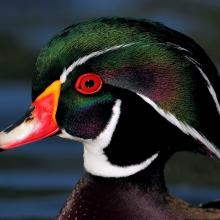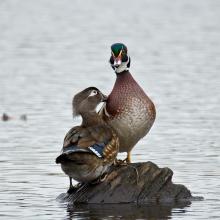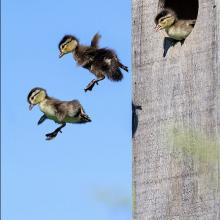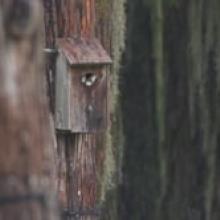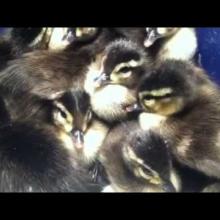

Join BirdNote tomorrow, November 30th!
Illustrator David Sibley and actor H. Jon Benjamin will face off in the bird illustration battle of the century during BirdNote's Year-end Celebration and Auction!
In the 1800s, Wood Ducks were possibly the most abundant ducks east of the Mississippi. But the draining of wetlands, the cutting of forests, and market hunting caused precipitous declines. In 1918, the Migratory Bird Treaty Act completely banned the hunting of Wood Ducks for 23 years. This protection - and the concern of dedicated individuals like Frank Bellrose - helped bring the Wood Duck back. Learn how to build the predator-proof nesting box that Bellrose designed, at Ducks.Org.
Support for BirdNote comes from the Cornell Lab’s Bird Academy, with online courses that share the wonder and joy of birds. More at AllAboutBirds.org.
BirdNote®
Frank Bellrose and the Wood Ducks
Written by Todd Peterson
This is BirdNote.
[Call of the Wood Duck]
The drake Wood Duck is perhaps the most beautiful of all North American ducks. His Latin name means dressed in finery ready for his wedding. Yet the Wood Duck once seemed threatened with extinction.
[Call of the Wood Duck]
In the 1800s, they were possibly the most abundant ducks east of the Mississippi. But the draining of wetlands, the cutting of forests [Sound of a tree falling] and market hunting caused precipitous declines. In 1918, the Migratory Bird Treaty Act completely banned the hunting of Wood Ducks for 23 years. This protection and the concern of dedicated individuals brought the Wood Duck back.
[Call of the Wood Duck]
Frank Bellrose was preeminent among those advocates. He became fascinated by the birds, while canoeing the Illinois River as a young man in the 1930s.
[Slap of water against a canoe. Sound of canoe paddle in water.]
Bellrose went on to study them for more than 50 years. His intimate knowledge of their ecology helped him invent a predator-proof nesting box that is now a mainstay of Wood Duck conservation.
We take care of what we value, what we devote ourselves to knowing. And one person’s dedication can make a crucial difference, as it did with Frank Bellrose and the Wood Ducks he loved.
[Call of the Wood Duck]
I’m Mary McCann.
Support for BirdNote comes from the Cornell Lab’s Bird Academy, with online courses that share the wonder and joy of birds. More at All About Birds dot org.
###
Sounds of Wood Duck provided by The Macaulay Library of Natural Sounds at the Cornell Lab of Ornithology, Ithaca, New York. Recorded by
Producer: John Kessler
Executive Producer: Chris Peterson
© 2014 Tune In to Nature.org April 2014/2021 Narrator: Mary McCann
ID# SotB-WODO-01-2011-04-15




